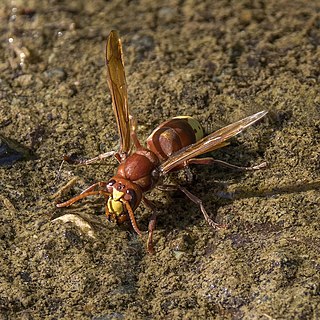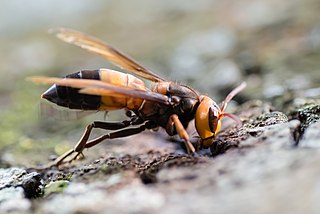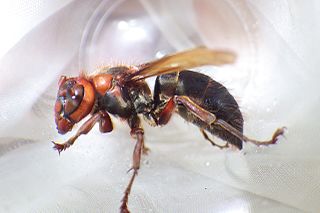
Hornets are the largest of the eusocial wasps, and are similar in appearance to their close relatives yellowjackets. Some species can reach up to 5.5 cm (2.2 in) in length. They are distinguished from other vespine wasps by the relatively large top margin of the head. Worldwide, 22 species of Vespa are recognized. Most species only occur in the tropics of Asia, though the European hornet, is widely distributed throughout Europe, Russia, North America, and north-eastern Asia. Wasps native to North America in the genus Dolichovespula are commonly referred to as hornets, but are actually yellowjackets.

Vespula is a small genus of social wasps, widely distributed in the Northern Hemisphere. Along with members of their sister genus Dolichovespula, they are collectively known by the common name yellowjackets in North America. Vespula species have a shorter oculomalar space and a more pronounced tendency to nest underground than Dolichovespula.

The Asian giant hornet or northern giant hornet, including the color form referred to as the Japanese giant hornet, is the world's largest hornet. It is native to temperate and tropical East Asia, South Asia, Mainland Southeast Asia, and parts of the Russian Far East. It was also found in the Pacific Northwest of North America in late 2019 with a few more additional sightings in 2020, and nests found in 2021, prompting concern that it could become an invasive species. There were no confirmed sightings in North America at all in 2022, however, by the end of the season in November, suggesting the wasps may have been eradicated in that region.

The European hornet is the largest eusocial wasp native to Europe. It is also the only true hornet found in North America, having been introduced to the United States and Canada from Europe as early as 1840. Vespines, such as V. crabro, are known for making intricate paper-like nests out of surrounding plant materials and other fibers. Unlike most other vespines, reproductive suppression involves worker policing instead of queen pheromone control, as was previously thought.

The Oriental hornet is a social insect species of the family Vespidae. It can be found in Southwest Asia, Northeast Africa, the island of Madagascar, the Middle East, Central Asia, and parts of Southern Europe. Oriental hornets have also been found in a few isolated locations such as Mexico and Chile due to human introduction. The Oriental hornet lives in seasonal colonies consisting of caste system dominated by a queen. The hornet builds its nests underground and communicates using sound vibrations. The hornet has a yellow stripe on its cuticle (exoskeleton), which can absorb sunlight to generate a small electrical potential, and this might help supply energy for digging. The adult hornet eats nectar and fruits and scavenges for insects and animal proteins to feed to its young. Because they are scavengers, the hornets may also serve as a transmitter of disease following consumption of infected plants. The hornets are a primary pest to honey bees, attacking bee colonies to obtain honey and animal proteins. The sting of an Oriental hornet can be quite painful to humans and some humans are allergic to stings.

The Philippine cobra also called Philippine spitting cobra or northern Philippine cobra, is a stocky, highly venomous species of spitting cobra native to the northern regions of the Philippines. The Philippine cobra is called ulupong in Tagalog, carasaen in Ilocano.

Nepenthes philippinensis is a tropical pitcher plant endemic to the Philippines. It is known from Palawan and the neighbouring Calamian Islands and Linapacan, where it grows at 0–600 metres (2,000 ft) above sea level.

The yellow-bellied whistler, or Philippine whistler, is a species of bird in the family Pachycephalidae that is endemic to the Philippines.

Provespa is a small genus of Vespidae, made up of nocturnal wasps from Southeast Asia, sometimes referred to as "night wasps" or "night hornets", though they are not true hornets. They are the only nocturnal members of the subfamily Vespinae, and also the only vespines where new colonies are formed by swarming. They tend to build their nests from fibrous plant material, making them a uniform greyish brown colour which is often difficult to locate.

Vespa tropica, the greater banded hornet, is a tropical species of hornet found in Southern Asia, New Guinea and west Africa, and which has recently been discovered to be an invasive species on the Pacific island of Guam. It is a predator of paper wasps and possesses a potent sting, which can cause extreme pain and swelling.

Ropalidia is a large genus of eusocial paper wasps (Polistinae) in the tribe Ropalidiini distributed throughout the Afrotropical, Indomalayan and Australasian biogeographical regions. The genus Ropalidia is unique because it contains both independent and swarm-founding species. Ropalidia romandi is one of the swarm founding species, meaning that new nests are founded by a large group of workers with a smaller number of inseminated females, while Ropalidia revolutionalis is independent-founding, meaning that each nest is founded by a single foundress.

The Asian hornet, also known as the yellow-legged hornet or Asian predatory wasp, is a species of hornet indigenous to Southeast Asia. It is of concern as an invasive species in some other countries.

Vespa bicolor, the black shield wasp, described by Johan Christian Fabricius in 1787, is a species of hornet which has been found to be the pollinator of an orchid, Dendrobium sinense, found only on the Chinese island of Hainan. Vespa bicolor also preys on honey bees, which it feeds to its larvae. The orchid produces a chemical that mimics a honey bee pheromone and attracts this predatory wasp.
Vespa luctuosa is a species of hornet which is endemic to the Philippines. The main subspecies is Vespa luctuosa luctuosa. Other known subspecies include Vespa luctuosa luzonensis and Vespa luctuosa negrosensis. Vespa luctuosa is known for its potent venom.
Apis mellifera cypria(Cyprus honey bee) is a subspecies of the Western honey bee. Its habitat is the Mediterranean island of Cyprus.

Vespa affinis, the lesser banded hornet, is a common hornet in tropical and subtropical Asia.

Vespa soror, also known as the southern giant hornet, is a species of hornet present in India, Northern Thailand, Laos, Northern Vietnam, and parts of South China, including Hong Kong, Guangdong, Fujian, and Hainan Island.

Vespa analis, the yellow-vented hornet, is a species of common hornet found in Southeast Asia.

Vespa dybowskii, also known as the black hornet or Dybowski's hornet, is a species of hornet found in Japan, Korea, Russia and China. It is considered rare or uncommon throughout its range. It has been suggested for attention in the Red Database in Japan.

Vespa binghami, also known as Bingham's hornet, is a species of hornet found in northern Thailand, Myanmar, Laos, parts of India, parts of China, Korea, and parts of Russia.

















